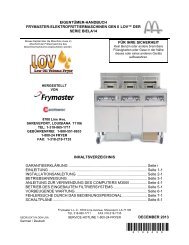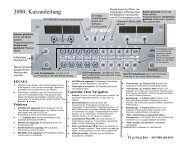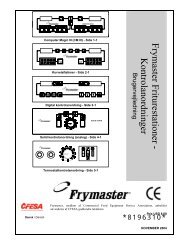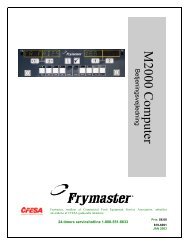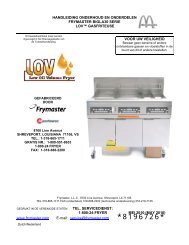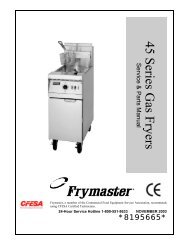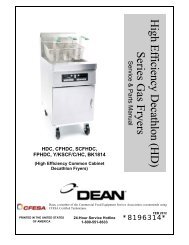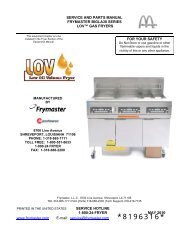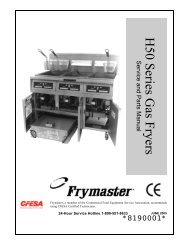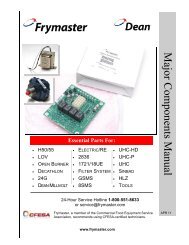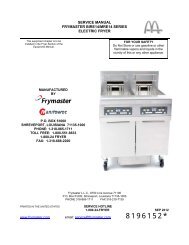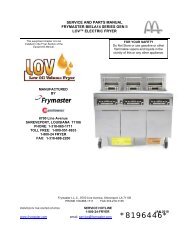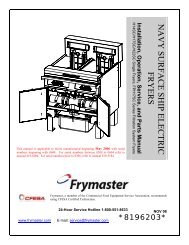Pro H50/55-Series Gas Fryers Service and Parts Manual - Frymaster
Pro H50/55-Series Gas Fryers Service and Parts Manual - Frymaster
Pro H50/55-Series Gas Fryers Service and Parts Manual - Frymaster
You also want an ePaper? Increase the reach of your titles
YUMPU automatically turns print PDFs into web optimized ePapers that Google loves.
1.1 Functional Description<br />
PRO <strong>H50</strong>/<strong>55</strong>-SERIES GAS FRYERS<br />
CHAPTER 1: SERVICE PROCEDURES<br />
<strong>Pro</strong> (<strong>H50</strong>/<strong>55</strong>) <strong>Series</strong> gas fryers contain a welded stainless steel frypot that is directly heated by a high<br />
efficiency infrared burner system requiring approximately 43% less energy than conventional<br />
burners to cook the same volume.<br />
Self-contained combustion chambers (referred to as “burners”) are fitted into rails attached to the<br />
sides of the frypot, one on each side. Each combustion chamber is fitted with special ceramic tiles<br />
that are heated by burning a forced air/gas mixture. The tiles transfer heat to the frypot by means of<br />
infrared radiation, providing much more constant <strong>and</strong> uniform heat dispersion over the surface of the<br />
frypot than conventional burners. Because less heat is lost to the atmosphere in the process,<br />
compared to “open-burner” designs, less fuel is required to achieve <strong>and</strong> maintain temperature.<br />
In full-vat units, gas flow to both of the burners is regulated by one electromechanical gas valve. In<br />
dual-vat units, each burner has its own valve. All fryers in this series are equipped with 24 VAC gas<br />
valve systems <strong>and</strong> electronic ignition.<br />
1.1.1 Electronic Ignition System<br />
An ignition module mounted in the component box<br />
(located behind the control panel) is connected to an<br />
ignitor assembly at the burner. The ignition module<br />
performs four important functions: it provides fuse<br />
protection for the 24-volt circuit, provides an ignition<br />
spark, supplies voltage to the gas valve, <strong>and</strong> proofs the<br />
burner flame. The module contains a 4-second time delay<br />
circuit <strong>and</strong> a coil that activates the gas valve. Three types<br />
are in use. A closed-box design is used in most fryers, but<br />
in some fryers built for export, the module resembles an<br />
interface board. A single dual-spark module is used on<br />
current production full-vat fryers. All dual-vat fryers use<br />
two single-spark modules.<br />
The ignitor assembly consists of a spark plug, an<br />
enrichment tube, <strong>and</strong> a flame sensor.<br />
1-1<br />
Out to<br />
<strong>Gas</strong> Valve<br />
To Alarm<br />
25 V +<br />
Inside the Ignition Module<br />
GND<br />
HV<br />
TD<br />
Coil<br />
Ignition Wire Flame Sensor<br />
At start-up, the power switch is placed in the ON position, supplying approximately 12-volts DC to<br />
the heat-control circuitry in the controller or computer <strong>and</strong> to one side of the heat relay coils on the<br />
interface board. If resistance in the temperature probe indicates the temperature in the frypot is<br />
below 180ºF (82ºC), the current flows through a melt cycle circuit where a timer switch alternately<br />
closes for 6 seconds <strong>and</strong> opens for 24 seconds. If the temperature is 180ºF (82ºC) or above, the<br />
current flows through a heat circuit, bypassing the timer switch. In either case, ground is supplied to<br />
the other leg of the heat relay coils, which then close electronic switches in the 24 VAC circuit to<br />
provide current to the ignition module. Circuitry in the ignition module sends 24 VAC to the gas



